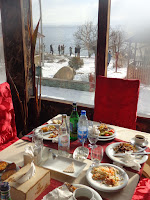Even when I ventured outside of downtown Yerevan, I found threads connecting Armenian culture, quite literally. At the Megerian carpet factory (top left), the owners' collection of antique rugs includes a piece that could be in the Genocide Museum: Two sisters who survived the atrocity were able to reunite and rejoin two halves of a carpet their mother had divided (top right). The factory, where all rugs are made by hand (bottom left), is creating replicas of the inspirational rug as gifts to people who have drawn awareness to the genocide, such as George and Amal Clooney. Although I saw the rug destined for the power couple, there sadly were no celebrity sightings at the post-tour on-site dinner (bottom right).
Besides my evening sojourn to the factory, I took two day trips to various famous sites outside the capital. On the first day, as the bus headed out of town, I saw a shiny-new -- and much larger -- production facility for Dargett Brewpub (top left), where at lunch the day before I sampled a flight of their diverse brews, including a Cherry Ale (top right). Never one to pass up experiencing the local beer culture, I also stopped by Kilikia Beer House, where I had an Elitar unfiltered lager with some pickled chickpeas (bottom left), and Beer Academy, where I had a Weizen Bock with my veggie-grill dinner (bottom right).The first stop of my first tour was Tsakhkadzor, a ski-resort city (left). The slopes were packed with what I presume were many amateurs, considering I saw two ambulances arrive and depart in the hour we stayed there. Even with the limited time, I managed to make it through the long line, so I could ride the ropeway to the top of the lowest peak. Despite it not being incredibly high, it provided a spectacular view of the surrounding snow-capped mountains (right).
Just a short drive away, we stepped off the bus and into Kecharis Monastery. I originally misheard and thought the monastery was named after khachkars, stone crosses so unique to Armenia that they are a UNESCO intangible cultural heritage (top left). In fact, the most likely source for the name of the still-active church is Kechror, a 12th-century Ararat city (top right). Because it was Apostolic Christmas, the altar area was even more packed than the ski slopes, with congregants witnessing the liturgy (bottom left). I found a different type of devout follower as I wandered around to the other ancient structures of the complex (bottom right).
From the resort, we headed down and east to Lake Sevan (top left). As the largest lake in the Caucuses and one of the largest freshwater lakes in Eurasia, it is home to many waterside hotels and restaurants, some of which stay active even in the winter (top right). The regional specialty is native trout, which is barbecued vertically on skewers within a stone oven (bottom left). I felt lucky to try some (bottom right), not only because the meat is delicious but also because the species is struggling. The country is trying its best to reverse the effects of Soviet water diversion, the same kind of which negatively impacted the Aral Sea.
Even with a belly full of fish, I managed to climb the stairs up to Sevanavank Monastery (top left). The 9th-century structure, which is still being reconstructed after a devastating 1936 earthquake, used to sit on an island but is now on a peninsula due to water-level manipulations (top right). The peninsula provides a lovely panoramic view of the the lake, although somewhat sullied by the fence that protects the president's summer residence (bottom).
The next day, the first stop on the tour was Garni Temple, a pagan offering to the sun, which unfortunately wasn't blessing us when we first arrived (top left). The Greco-Roman structure sits above a gorge of the same name, which is home to the uniquely hexagonal geological formation Symphony of the Stones (top right). Also on the plateau sit the ruins of a Roman bathhouse, including a well-preserved mosaic with Greek lettering that roughly translates to "we worked for no pay," which I found apropos, considering this trip was during the longest U.S. government shutdown in history (bottom left). But the saddest part about the site was that, although the temple is one of the oldest structures in the country, it was not accepted as a UNESCO World Heritage site because it wasn't restored properly; for example, concrete was used to replace missing pieces that weren't discovered until after the reconstruction (bottom right).
The region compensates by offering many nearby outlets for lavash baking, which has been recognized as a UNESCO intangible cultural heritage (top). The ubiquitous bread is made from a simple combination of flour, salt, and water that is stretched thin through tossing, much like pizza dough (bottom left). The dough is wood-fired, but unlike pizza crust, it is placed directly upon the walls of a pit oven with the help of a pillow-like pad. Lavash is eaten in many ways, but the most traditional, per my guide, is hot out of the oven with some fresh cheese and herbs (bottom right).
It was clear the tour saved the best for last when we turned the bend into Geghard Monastery, built in an area that had already become well-known due to the monastic cells that cropped up in the cliffs next to a reputedly regenerative spring (top left). The noble family, whose crest is carved inside, preserved the spring when it created the church's alcoves within the rock (top right). Like Sevanavank, the monastery was partially destroyed by earthquakes. As if a sign from god, during its grand opening after reconstruction, a rock fell from the nearby cliffs and landed in the courtyard (bottom left). Unlike Garni, the rebuilding was done properly, so the complex hidden in the Azat Valley became a UNESCO World Heritage site (bottom right).
































No comments:
Post a Comment